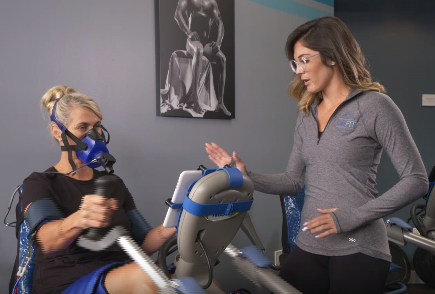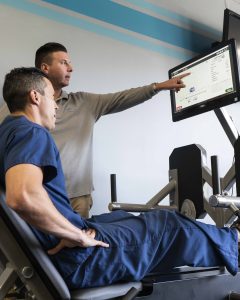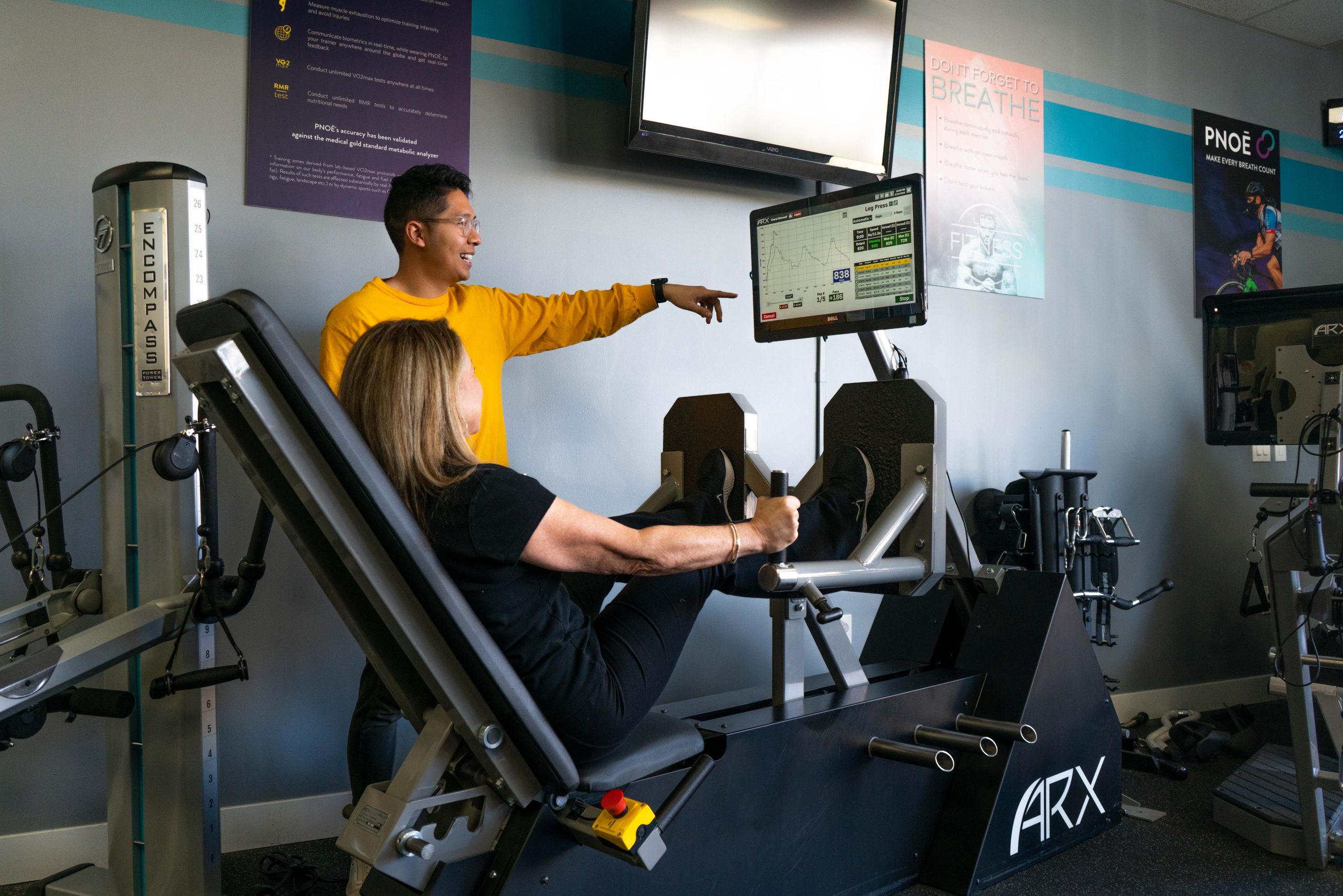There are many crash diets out there, and all promise quick weight loss. And if you follow them, you can temporarily lose weight. But science proves that you regain that weight 95% of the time.
Using science, Leo’s Fitness Lab can now prevent you from gaining that weight back.
We all know that to lose weight, you must eat fewer calories than you burn. The problem is, if you cut too many calories, your metabolism slows down. Your body starts to burn even fewer calories every day. It starts burning away muscle to reduce your calorie needs.
To successfully lose weight permanently, you must eat a specific number of calories to keep your metabolism fast, yet still lose weight. So how many calories do YOU need to lose weight permanently?
Our PNOĒ metabolism test will scientifically measure and tell you how many calories you need to maintain permanent weight loss.
Just Do These 6 Things to Permanently Lose Weight:
- Take our PNOĒ metabolism test.
- Discover the specific number of calories to eat each day.
- Track your calories on an app for one month.
- Lose weight.
- Retake the PNOĒ metabolism test.
- Adjust calories as needed to continue to achieve your ideal weight.
Without measuring metabolism, you will not know whether you are losing weight without slowing your metabolism. If you test monthly, you can adjust your calories for PERMANENT weight loss.
Doing anything else is guesswork, and that is why 95% of diets fail in the end.
Don’t fail this time! Call Leo’s Fitness Lab NOW to schedule your PNOĒ metabolism test and get started on the last diet of your life. 619-299-1694
CONTINUE READING FOR A DETAILED ANALYSIS OR JUST BOOK NOW!
Definition of metabolism for this article: the number of calories you burn per day.

Situation Summary
You decide to diet, cut too many calories (crash diet), and your metabolism slowly decreases. You hit your goal, but because your metabolism has slowed, all the weight returns, often plus a little more. You repeat the cycle. You lose the same 10 -20 pounds over and over your entire adult life.
The Data
Ninety-five percent of normal diets don’t work – but there is a solution!
Hard research has shown that 95% of diets don’t work and that all the weight returns within a year PLUS MORE. This is why many Americans become fatter and frailer as they age.
There are three PROBLEMS and two SOLUTIONS to fix this 95% failure rate and ensure diet success.
Problem One
The first reason for diet failure is simple: “Crash Diets.” Most people cut too many calories on a diet, and this causes their metabolism (a person’s daily calorie burn) to slow down, and sometimes permanently.
Example
A 5 foot 10-inch man weighs 200 pounds and has a 25% body fat percentage. He wants to lose 20 pounds. These numbers mean he has 150 pounds of lean tissue (bone, sinew, muscle) and 50 pounds of fat on his body frame. In this example, let’s say he typically burns 2800 calories a day. He decides to do a crash diet, so he cuts his calories to 1500 a day. But 1500 calories a day is way too low, so (over time) his brain thinks he is starving. The brain then lowers its daily caloric needs (metabolism) down to 1500 calories. The brain does this primarily by reducing muscle cells, because this is where most calories are “burned.” This is a double whammy. His caloric need is reduced, and he loses his most metabolically active tissue: muscle.
He is miserable on this low-calorie diet, but his scale shows show the numbers going down on this 1500 calorie “crash weight loss diet.” He is happy watching the numbers on the scale, BUT half or more of the “weight loss” is muscle. But he didn’t want to lose muscle; he wanted to lose 20 pounds of fat.
But as miserable as it is, he is pleased because his waist is an inch or two smaller, so he buys new pants. (How many of us have a set of fat clothes and slim clothes?)
At 200 pounds with 25% body fat, he felt overweight and didn’t look that good. He had hardly any muscle definition because a layer of fat covered his muscles. And maybe he maybe he had a slight gut (protruding stomach). At 180 pounds, does our example man look any better? No, He is just a smaller version of his former self! Still no muscle definition and a smaller gut!
But the math shows another situation.
Math
A 200-pound man with 25% body fat loses 20 pounds. But he loses 10 pounds of fat and 10 pounds of muscle. He now weighs 180 lbs.
He now has 140 pounds of lean tissue and 40 pounds of fat. 40 divided into 140 is 28.5% body fat. He was only 25% before he started the diet.
His scale says he weighs less, but percentage-wise, he is FATTER! 28.5% versus 25%!!!
Hint: His brain would not likely notice a 300-600 calorie a day reduction, so his metabolism should stay at, or near, 2800 per day. In this case, he would mainly lose fat and not muscle.
This calorie-reduction diet will take longer to lose the desired fat weight. But weight loss becomes permanent if your metabolic rate stays the same (2800 calories daily).
You NEVER want to lose muscle because that is the healthiest part of your metabolism.
The news gets even worse. The dieter’s metabolism is down to 1500 calories the day he stops dieting. As he goes back to eating “normally,” his metabolism will go somewhat higher, but in most cases, it will not go back to 2800 calories per day for basic bodily needs. This means he starts gaining weight simply by eating what was “normal” before the diet.
Problem Two
The weight comes back, primarily as fat, and when he hits 200 pounds again, he decides to go on another “crash diet” and the above repeats. And he gets a little fatter each time he diets off the 20 pounds per the above “formula.”
Problem Three
Research has shown that crash diets can cause PERMANENT metabolism damage in the form of PERMANENT lower calorie needs for daily body needs and functions. So, one must eat less and less to lose weight. You may even have to eat less just to stay at the original weight.
This is why doctors and diet consultants say, “The average American loses the same 10 or 20 pounds over and over again their entire life.” And by the time they are 60, 70, or 80 years old, they are frail because they have dieted their muscles away. Being frail at age 80 is NOT normal. It is actively caused by poor dieting and NOT exercising correctly or not exercising at all. (More on proper exercise later.)
What is the solution to the problem of a) losing weight, b) being fatter at the end of the diet c) gaining fat back, and d) plus gaining even more fat.

The First Solution to the Three Problems
One first needs to know THEIR OWN SPECIFIC METABOLIC RATE so you can deduct the appropriate number of calories for permanent FAT loss. Remember, we are not trying to lose “weight,” we are trying to lose FAT.
We have a medical device called PNOĒ (this means “breath” in Greek), which measures your breath to determine your daily caloric needs. Fat is “burned” and leaves your body primarily through your breath. Thus, the PNOĒ gives you an accurate metabolism rate to deduct the correct number of calories for a successful diet.
You do not want to guess what YOUR caloric metabolism is; you want to know so you can reduce the correct number of calories to cut from your diet for permanent weight loss.
Our PNOĒ test will tell you this number.
Then, you test again in a month to see if the reduction of calories you reduced was correct. Did your metabolism go down a little or a lot? It may go down a little because you are losing weight. But if it goes down a lot, you are wasting your time. The weight will return because you will lost muscle and have a lower metabolism. And you will suffer because 1500 calories for a 200-pound man is miserably low.
But if you test monthly, you can adjust your correct calorie reduction for PERMANENT FAT loss as needed.
Doing otherwise is guesswork, and that is why 95% of diets fail in the end.
The 95% failure rate in one line: You either eat too little and suffer, so you quit, or you stubbornly attain your goal with a lowered metabolism, and the weight returns.
Personal Note
I have gone from 250 pounds to 220 pounds, and when using the correct number of calories to lose about one pound a week, I was never hungry, and my metabolism stayed in roughly the same range. I used PNOĒ monthly throughout to monitor my metabolism, and I did have to adjust a few times, but my weight is now stable.
On the other hand, I once tried the new weight loss drug Ozempic (Semaglutide), which, for me, took away almost all feelings of hunger. COOL and easy. I lost 10 pounds very quickly but when I tested my metabolism with PNOE before and after the weight loss, my metabolism had crashed. As soon as I started eating normally (off the drug) the weight came back almost instantly as fat. NOT SO COOL. So, I am speaking from personal experience.

The Second Solution to the Three Problems
You must maintain or build muscle while you’re dieting. Muscle burns calories; fat doesn’t.
Most exercise consists of moderately light weight – three sets of 10 – weightlifting, or some kind of aerobics. We’ve been doing both exercises for the past 50 years and Americans are fatter than ever.
So obviously, those exercises don’t work for weight loss. There is a reason for that. These activities are basically just body movement which doesn’t build or maintain muscle while you’re on a diet.
Current published research shows, believe it or not, that aerobic exercise can CAUSE weight gain! Again, after 50 years of doing aerobics, Americans are fatter than ever.
The actual solution to maintain or build muscle is to stress the muscles to the point of temporary failure. Thus, the brain thinks that there is a risk to survival and will build more muscle to compensate.
Our computer-controlled weight training machines give you the exact but safe amount of “stress” which will cause your body to maintain or build muscle even while dieting.
To Sum Up
- You need to do our PNOĒ test to discover the correct number of calories to eat to lose weight and not gain it back, and
- You need to exercise in a way to maintain and build muscle using our state-of-the-art technology.
This can all be done in 20 minutes twice a week.
Call Leo’s Fitness Lab and set up your PNOĒ test today! You have nothing to lose but permanent weight loss! 619-299-1694.



